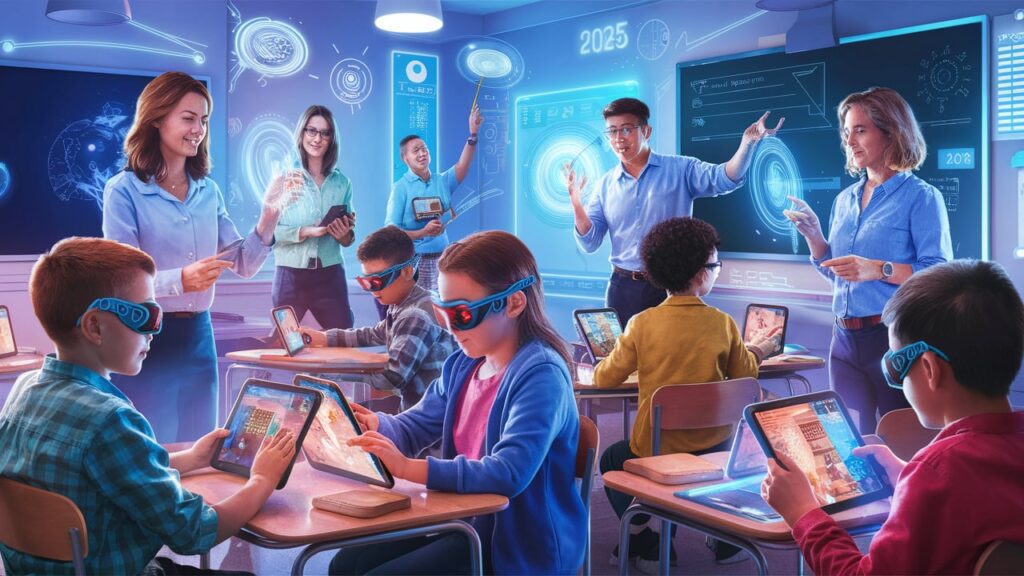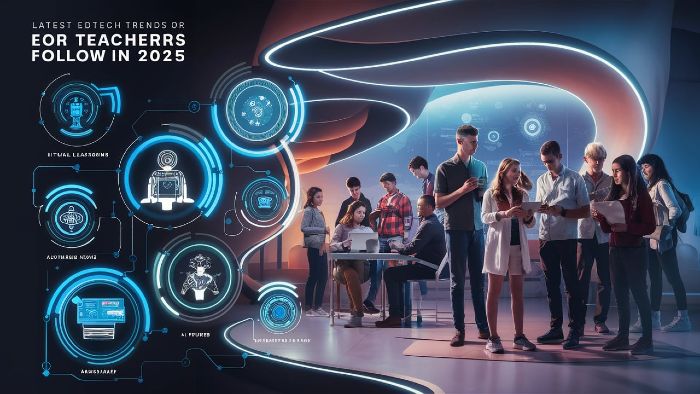The world of education is changing rapidly. The learning environments of students and the teaching approaches of teachers are being altered by new technology tools. In 2025, teachers should be able to change. By adopting new EdTech trends, it is possible to enhance classroom interaction and increase student achievement. Educators that support new innovations are able to provide a more satisfactory experience to all learners.
Personalized Learning Platforms
Teachers are in a position to differentiate by using data driven platforms. These applications examine the performance of the students and recommend material to suit the learning rate. It also makes sure that no student is left behind and none feels like they are being pushed. Individualized learning adds value to education and it is inclusive. It is weighed toward meeting the personalization needs of individual learners, rather than a blanket solution.
Boost your learning with these free online platforms with certificates and learn coding at home step by step. Improve study habits using note-taking strategies and memorization techniques.
The use of Gamification in Classrooms
Gamification makes learning more fun. It incorporates game mechanics such as badges points and leaderboards. Students remain enjoined and involved. Educators find it less difficult to maintain attention and participate. It makes boring classes into fascinating tasks. Education that is gamified can enhance memory capacity and peer-to-peer collaboration.
Robot-assisted Tutoring Software
AI assists instantly and gives feedback. They are beneficial to the students by enabling them to learn without a response of the teacher. These tools can help teachers to save time. Their activities are based on critical thinking, rather than grading. AI tutors do not sleep. It also makes sure that learners are assisted when they require assistance.
Augmented and Virtual Reality Experiences
AR and VR establish a learning environment. They give students the ability to travel without leaving the room. Virtual field trips and science simulations can be guided by the teachers. It promotes visual interaction in making it understand. These instruments will make abstract things concrete. The learning becomes interesting and influential.
Microlearning Modules
Microlearning is learning in small bits. It fits on short attention spans and tight schedules. Teachers may present using videos quizzes or brief texts. Pupils learn at a higher rate and in a more permanent manner. It helps in revision and tests preparation. Microlearning is applicable on mobile devices as well.
Group Digital Workspaces
Teachers and pupils are able to work together in real time. Documents ideas and feedback can be shared on platforms. It enhances communication and collaboration. Assignments are easily handled and contributions are tracked by teachers. The students develop cooperation and problem solving skills. It creates a networked and mobile classroom with digital workspaces.

LADs
Analytics reveal the student performance. Dashboards and reports provide teachers access to insight. It aids in the determination of gaps and strengths. Teachers manipulate tactics with actual evidence. Analytics are the motivation towards superior decision making and goal setting. Early intervention can enable teachers to assist struggling learners. It results in increased academic achievement.
Adaptive Tools of Assessment
Adaptive tools increase or decrease difficulty depending on a response. It guarantees correct measuring of skills. Educators do not waste time when creating and assessing tests. Learners are asked questions that are at their level. Results are immediate and obvious. Adaptive tests lower the anxiety degree of the test. They are better indicators of learning development compared to conventional assessments.
Online Citizenship and Internet Safety
Educators should educate about safe internet usage. Students must learn ethics and privacy online. It is influential in the era of social community and online tools. Lessons about safe browsing and cyberbullying are conducted on the platforms. Educators support students in creating a favorable digital identity.
Voice Technology Education
Smart speakers are voice-based tools that increase classroom interaction. Students pose queries and receive answers immediately. The voice commands enable teachers to manage lessons and resources. It assists struggling or weak writers and readers. Learning is easier and more inclusive due to the voice technology.
Education Blockchain Records
Academic records are secured using blockchain. It discourages fraud and makes simple verification. Digital certificates can be issued by teachers and schools. Students share and get access to achievements non-hazardously. It eases recordkeeping and minimizes paperwork. Blockchain enhances faith in education system.
Social Emotional Learning Applications
The SEL apps address the well-being of the students. One of the activities that they use in tracking emotions and behavior is through teachers. It assists in stress coping and empathy development. The students think over emotions and eliminate conflicts. Use of SEL results to healthier learning environment. Teachers develop better relationships with students.
Learning Management Systems
LMS systems in the cloud concentrate contents of courses. Teachers plan teaching tasks and grade in an effective way. Students have the ability to access materials on a 24-hour basis. It enhances elasticity and missed lessons. The use of clouds enables instant changes and messaging. The teachers can monitor progresses and adjust teaching easily.
Smart displays and Digital Whiteboards
Traditional boards are changed to interactive displays. Teachers are capable of drawing and sharing content on the fly. Students communicate with lessons with the help of touch and stylus devices. It enhances creativity and visual learning. Interactive boards make hybrid or distance learning easy. These technologies fill in the spaces of physical and online classrooms.
Educational Podcast Authors Tools
Today, teachers turn to podcasting in order to provide audio. It is more accommodating of audience learners and aids revision. Students can listen in transit and speed when necessary. Stories and examples are used when teachers convey something complicated. It develops the listening and increases content diversity. Podcasts involve the learners even beyond the classroom.
Special Needs Virtual Reality
Students with disabilities can utilize VR. It develops focused communications and motor skills. VR apps assisting in teaching and therapy can be used by teachers. There is less stress and comfort within immersive environments. The tools enhance access and inclusion. Learners with special needs are exposed to formative virtual experiences.
Robotics integration
The use of robots in classrooms imparts programming as well as STEM skills. Using the robots, the teachers can give practical projects. Coding logic and collaborations are learned by students. It stimulates experiment and thoughtfulness. Robotics educates students on the future careers. Robotics in education is interesting and successful in project-based education.
Digital Flashcard Apps
Flashcards are technologically changing. Teachers make their own sets with picture and sound. Students learn to revise quickly and test themselves on the move. These applications facilitate spaced repetition. It enhances memorizing and performance in tests. Digital flashcards are applicable in self-guided and cooperative learning paradigms.
Online Argument and Discussing Forums
The forums are used by teachers to initiate discussions. Students exchange views and are taught how to constructively argue. It develops writing and oral presentation skills. Even shy students express themselves in forms. Educators evaluate insights using critical answers. Online discussions take classroom discussions to further thought.
Real-Time Voting and Feedback Software
Polling on the spot increases conversation. During classes teachers pose the questions and watch the answers in real-time. It makes students stay awake and engaged. Polling instruments demonstrate knowledge gaps. Educators make changes according to review. Students become listened-to and involved. It encourages hands-on learning in each topic.
Parent communication via EdTech
Apps and portals help teachers get in touch with parents. They exchange grades, attendance, and updates in real-time. At home, parents monitor achievements and assistance. It creates confidence and engagement. The teachers take less time on the phone or meetings. The benefit of communication enhances student results and responsibility.
EdTech Professional Development
Educators engage in EdTech to develop. Learning platforms and webinars on online courses are helpful. It reminds them of the emerging trends. Busy people can learn at their own pace. Teachers acquire certifications and skills online. Continuous growth enhances both quality of teaching and achievement of students.
Advance your career with must-have skills and explore AI in education. Try live tutoring platforms, manage homeschooling multiple kids, and find affordable homeschool curriculums. Explore more at Study.com.
Pros and Cons of EdTech Trends
| Trend | Pros | Cons |
|---|---|---|
| Personalized Learning | Improves outcomes for all students | Requires consistent data input |
| Gamification | Increases engagement | May distract from core learning |
| AI Tutoring | Offers instant feedback | Can reduce human interaction |
| AR and VR | Enhances concept understanding | Needs expensive equipment |
| Microlearning | Faster knowledge absorption | Not ideal for complex topics |
| Analytics Dashboards | Helps spot issues early | May over-rely on numbers |
| Blockchain Records | Secures academic data | Adoption is still limited |
| Robotics | Enhances STEM skills | High cost of devices and training |
| VR for Special Needs | Improves accessibility | Requires customization and support |
| Podcasting Tools | Boosts auditory learning | Not suitable for all students |
How Teachers Can Integrate These Trends
Teachers are advised to start with small. They will be able to select one or two tools and discuss the features. It can be assisted by attending workshops and webinars. This helps develop confidence with others. Teachers ought to innovate, adjust and educate. Student feedback is also important. It directs improvement and welcomes contributions.
Learn about other techniques that may be adopted in contemporary education at InstituteInfo.
Ordered List:
- Choose the EdTech tool
- Learn its features
- Apply it in class
- Collect feedback
Unordered List:
- Microlearning videos
- VR history tours
- AI-based quizzes
- Collaborative docs
Future of EdTech for Teachers
EdTech will continue to evolve at a fast rate. Educators should be inquisitive and active. This requires lifelong learning. Schools should facilitate professionals. Pedagogy not technology. Teachers are the key involved in directing the success of students. Purposeful embrace of trends has a life-long effect.

FAQs
Which are the biggest EdTech trends to keep in mind among teachers in 2025?
One of them is personalized AI-powered learning. It aids in customizing the content to the needs of the students.
What are the best practices in order to teach teachers how to use new EdTech tools?
Teacher training and confidence is fostered in online courses webinars and peer collaboration.
Are EdTech tools costly?
There are some free or low-cost tools. Quality investments can be made by schools when they begin with necessities.
Will students gain more with digital learning?
Digital learning, when applied effectively, increases engagement and achievement across the subjects.
Is the use of AI safe in classrooms?
There is a yes when tools are guided by ethical standards and teachers oversee their employment.
Final Thoughts
The teachers should discuss new opportunities in technology. 2025 provides outstanding resources to change classrooms. One should not be concerned about learning just tech. By thinking carefully through EdTech it will enable all students to succeed. By being informed and inspired, teachers influence the future.

